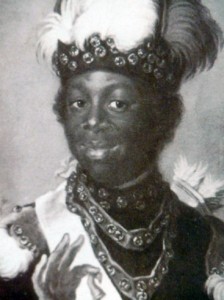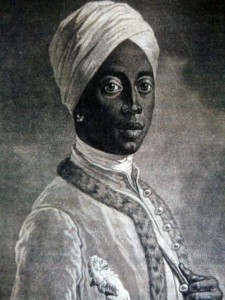
Supreme Court’s Robust New Session Could Define Legacy of Chief Justice
October 6, 2014
Bosnian immigrant finds community in intramural soccer
October 6, 2014BY RUNOKO RASHIDI*
Adolf Badin: Distinguished African of the Swedish Court
In spite of severe limitations, a number of Africans managed to distinguish themselves on the European stage even during the period of the massive enslavement and transport of African people from Africa to the Western Hemisphere. In our section on Europe, we have looked at a number of them. It is impossible to cover them all. Several more of them, however, have captured our imagination and are impossible to ignore.
One of the most interesting of all the Africans in the history of Europe was Adolf Badin (1747-1822). By far the best summary of Badin’s life is Madubuko A. Diakite’s 2005 article written in Lund, Sweden, African Diasporans in Sweden: An Unfinished History. In this excellent and sensitive work, the author points out that African people, referred to as “blue men” and “Morianen,” have been living in Sweden at least since the 14th century. However, by far the most famous African in the history of Sweden is Adolf Badin, born into slavery in the Danish colony on the Caribbean island of St. Croix in 1747.
Bought by the captain of a Danish ship, this bright and precocious African child, whose original name seems to have been Couschi, was in 1757 presented as a gift to Sweden’s Queen Lovisa Ulrika. Under her direction, he was converted to Christianity, tutored in French, German and Latin, and given the name Adolf Ludvig Gustav Fredrik Albert Badin. His childhood playmate was the person who would one day be Swedish King Gustav III.
Ultimately, Adolf Badin the African became an important member of the Swedish court. Among other things, he was a roving ambassador and even royal weather forecaster and court chess player. He possessed a library of 800 books and twice married aristocratic women, although he produced no offspring.
Adolf Badin died in 1822 at about the age of 75. He had lived through the reigns of at least three Swedish kings. Badin’s widow, Magdalena Eleonora Norell, was known as the “moriansankan” or morian’s widow.
In spite of four fictional biographies about him, a commemorative stamp and his portrayal as a minor character in several Swedish plays and films, Badin has been almost completely ignored in Swedish history books.
A beautifully appealing, highly dignified and smiling pastel portrait of Badin, magnificently arrayed and done by Gustav Lundsberg, hangs in Sweden’s National Portrait Gallery in Stockholm. He is portrayed playing chess and dressed in a Free Mason’s uniform with a hat adorned with ostrich plumes. In addition to this portrait, there were exaggerated contemporary caricatures of Badin published that showed him dwarfish and ape-like.
Adolf Badin remains the most famous African in the history of Sweden.
Anton Wilhelm Amo and Angelo Soliman of Germany and Austria
The fascinating and even bizarre story of Angelo Soliman (1721-1796) takes place in the city of Vienna — the 18th century capital of the German Empire. Indeed, the only other African in the region approaching the stature of Soliman was Anton Wilhelm Amo (1703-1756). Amo was born in 1703 near the town of Axim in what is now Ghana. Around 1707, he was seized by slavers, transported to the Dutch West Indies, presented to the court and given to Duke Anton Ulrich von Braunschweig-Wofenbüttel. The Duke handed him over to his son August Wilhelm. In 1708, Amo was christened with the names Anton Wilhelm after his patrons. In 1721, he was baptized.
In 1727, Anton Wilhelm Amo, educated with support from the Princess of Braunschweig, attended Halle University, learning Latin, Greek, Hebrew, French, German and Dutch. In 1729, he graduated from Halle. In 1730, he attended Wittenberg University and in the same year attained the degree of Doctor of Philosophy. In 1733, on the visit of Augustus the Strong, Elector of Saxony and King of Poland, Amo led the students’ procession in Augustus’ honor. As his disputation was published, Amo was made professor of philosophy.
In 1736, Dr. Amo returned to Halle where he taught psychology, “natural law” and the decimal system. In 1738, his treatise on The Art of Philosophizing Soberly and Accurately was published. The following year, he moved to Jena University where he gave his inaugural lecture on The Frontiers of Psychology.
Dr. Amo remained at Jena until May 1740. The two sons of Duke Anton Ulrich died in 1731 and 1735, and when Johann Peter von Ludewig, chancellor of Halle University, died in 1742 Amo had no other patrons in Germany. Amo eventually returned to Axim, Ghana, where he died in 1756 in a Dutch fort.
The Martin Luther University of Halle-Wittenberg now has an annual Anton Wilhelm Amo Prize of DM 2,000 in his honor.
Angelo Soliman was the educator of a hereditary prince and an associate of Mozart. He was celebrated in life and humiliated in death, his body eventually being put on display.
Soliman was born in Africa, probably in what is now northeastern Nigeria, around 1721. His original name may have been Mmadi Make. As a young boy, around 1728, he was captured by slave hunters and brought on a Spanish ship to North Africa. In 1730, he was taken to Messina, Sicily, and raised in a wealthy household. Soon baptized as a Catholic, he was allowed to choose the name “Angelo” in accordance with “Angelina,” the name of an African servant in the same house whom he loved very much. His surname “Soliman” was added at the same time.
Sometime between 1732 and 1734 Soliman was made a gift to Prince Johann Georg Christian Lobkowitz — the then Austrian governor of Sicily, who desired to have Soliman as a member of his court. Exactly what Soliman’s attributes were that led to his life of relative privilege we are not certain, as it would seem that although serfdom was prevalent, chattel slavery itself did not formally exist in the German Empire. We do know that it was in vogue within the circle of European aristocracy at the time to have one or more African servants. And some of these Africans rose to very high positions within society. Apparently Angelo Soliman, highly talented and blessed with great intellectual gifts was one of these Africans.
Lobkowitz took Soliman to Bohemia, where the youth was instructed in German, Italian, French, Latin, Czech and English. Finally, Soliman with Lobkowitz went to war, as qualified servants were allowed to, once even saving the life of the wounded by carrying him away from the field of battle on his own shoulders.
After Lobkowitz’s death in 1753, Soliman entered the service of Prince Joseph Wenzel Liechtenstein’s (1696-1772). In 1761, he accompanied Liechtenstein to Frankfurt, where Joseph I was selected king of the German Empire.
Soliman’s reputation as a “noble Moor” and a protector of the poor and downtrodden grew rapidly. In 1768, he married Magdalena Christiani. When Liechtenstein heard of Soliman’s marriage, he fired him immediately. After his dismissal, Soliman and his wife lived in their own small house in a Vienna suburb, and enjoyed the company of an elite circle of highly educated people. Their only child Josephine was born in 1772.
In 1773, Prince Franz Joseph of Liechtenstein (1726-81), nephew of Joseph Wenzel, paid Soliman an annual salary in return for Soliman performing the supervision over the education of Liechtenstein’s son, hereditary prince Alois (1759-1805). Thus having secured once again a level of financial security, the Soliman family moved again to Vienna and lived in the Liechtenstein palace. Soliman was now the educator of a hereditary prince, a similar position held by Abraham Hannibal (1696-1781), the maternal great-grandfather of Alexander Pushkin, who taught mathematics to the then-crown prince of Russia in 1725. Soliman maintained this position until 1784.
In September 1781 Soliman joined an elite Vienna lodge of Freemasons known as the “True Concord.” Other members of the lodge included Wolfgang Amadeus Mozart and Joseph Haydn. Soliman ́s Freemasons name was “Massinissa.” Massinissa (240-148 B.C.E.) was the long lived king of North Africa’s Numidian empire (in present day Algeria), and Soliman‘s identification with him indicates a clear awareness of his African ancestry.
On Nov. 21, 1796, Soliman, at the age of 75, died from a stroke while walking in the streets of Vienna. He was brought home, and there began the great scandal by which he is widely known. Shortly after his death, Soliman’s internal organs may have been removed as some part of his body was buried two days later. Then, at the express orders of Emperor Francis II, the corpse was transferred to the faculty of medicine where “experiments” were carried out. Subsequently, the remains were delivered by the request of an Abbé Eberle, under whose care the body was skinned, stuffed, and put on display in the Natural History Museum of the Imperial House of Austria. According to one account, “the corpse was skinned, the skin stretched over wood, and the virile figure of Angelo Soliman restored with striking verisimilitude. For 10 years, it was exhibited to public view.” The first source for these facts was an Episcopal appeal, addressed to the Imperial government and referring to a now-lost letter of Soliman’s daughter. The then-director of the Imperial Museum declared that Soliman’s beauty caused in the then-emperor the desire to let him be displayed as a stuffed artifact in his museum.
For 52 years, Soliman’s stuffed skin, displayed as an African, was exhibited alongside stuffed animals including marsh birds and an aardvark. Finally, in 1848, during a revolutionary uprising, the building housing Soliman’s mortal remains was set on fire and his body destroyed, thus ending perhaps both the most remarkable and grotesque example of Central Europe’s little-known African Diaspora.
Sources:
ADOLF BADIN, ANTON WILHELM AMO AND ANGELO SOLIMAN: A BIBLIOGRAPHY
Angelo Soliman: The Princely Moor. Travel Beyond Borders, Volume 1, Issue 1 (September 1999): 5-6.
Diakite, Madubuko A. African Diasporans in Sweden: An Unfinished History. Lund, Sweden, 2005.
Firla, Monika. In Search of the Viennese African, Angelo Soliman (ca. 1721-96): From Educator of a Hereditary Prince to Stuffed Exhibit. TINABANTU (Cape Town), Volume 2, No. 1 (2004): 75-90
Fleming, Beatrice Jackson. Angelo Soliman. Negro History Bulletin, Volume 4, No. 3 (December 1940).
McClendon III, John H. Anton Wilhelm Amo: African Philosopher in Europe — A Brief Biography and Historical Considerations. Paper submitted at The Conference on Africans in Europe before the 20th Century. December 8-10, 2005. University of Toulouse. Toulouse, France.
Nettl, Paul. Angelo Soliman — Friend of Mozart. Phylon, Volume 7, No. 1 (1946): 41-46.
Pred, Allan. The Past is Not Dead: Facts, Fictions, and Enduring Racial Stereotypes. Minneapolis: University of Minnesota, 2004.
Sauer, Walter. Das afrikanische Wien. Vienna: SADOCC, 1996.
*Runoko Rashidi is an historian, anthropologist, lecturer and world traveler. To date, he has authored or edited 18 books about history and travel. He is currently based in Los Angeles and regularly leads African-heritage tours. His next tours are to Cameroon in December 2014 and Ethiopia in May 2015. For further information write to Runoko at Runoko@hotmail.com or call him at 323-920-6055.



